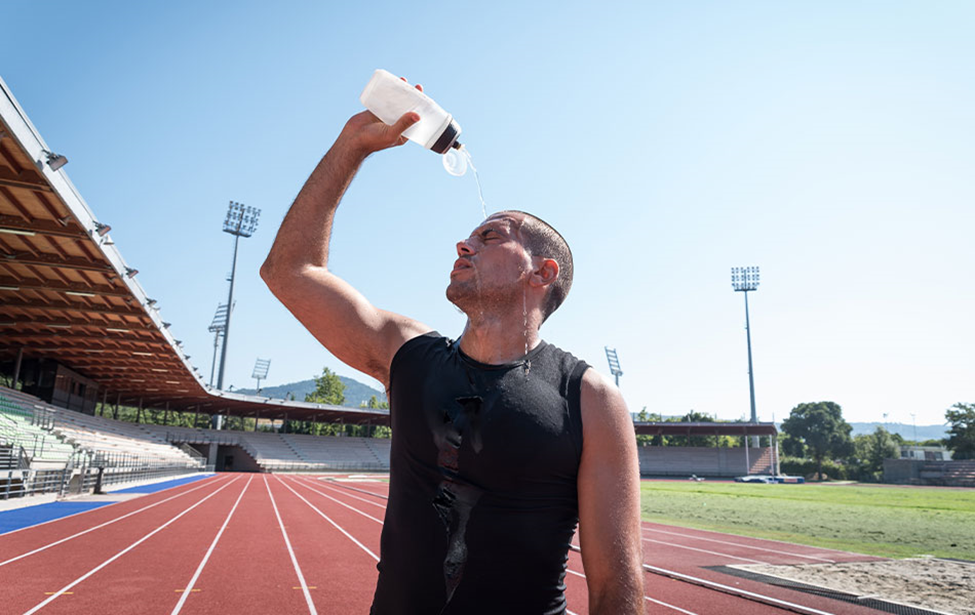Hydration to Maximise Performance and Recovery
- Niamh Fogarty

- Jan 15, 2024
- 4 min read
Be prepared or prepare to fail
With many athletes (including myself!) away on warm weather training, I felt that now would be the perfect time to highlight the importance of fluids in the diet. Prior to going on camp, it is essential to have a plan in place so that training runs smoothly and that you get the most out of your time there. This includes things like planning training sessions (you don’t want to do too much too soon) and recovery days, whilst factoring in other elements that are important for performance like food, sleep and hydration.
When we exercise, our heart rate increases and blood is pumped around the body quicker in order to maximise the amount of oxygen getting to our muscles. In response to this, heat is produced, our temperature rises, and the body tries to cool us down by releasing fluid (in the form of sweat). When we sweat, not only do we lose water but also sodium, which is a natural electrolyte important for fluid regulation in the body (read more here). To ensure that performance and future performances are not negatively impacted by fluid loss, it is crucial that the body is appropriately hydrated before, during and after exercise.
How much should I drink before exercise?
It is widely known that carb loading days prior to a race can help with performance, as energy stores (i.e. glycogen) are built up. However, the same does not apply for ‘fluid- loading’ or ‘hyper-hydration’ prior to ultra-endurance events, as our body can only store and use so much water. Instead, athletes should try to maintain hydration levels in the build up to exercise.
It is recommended that athletes sip 5-7ml of water per kg of body weight 2-4 hours before exercise (1-2). For a 70kg athlete, that is just under half a litre (350ml - 490ml). I personally take this approach of sipping water, both before and during training, because I find it easier on my stomach when I am running or jumping. I don’t know about you, but drinking too much too quickly leaves me feeling uncomfortably full and bloated.
How much should I drink during exercise?
The amount you need to drink during exercise to replace the fluid lost will be influenced by many factors. These include body weight, gender, exercise type, exercise intensity and duration, as well as the environment.
While drinking water helps keep the body hydrated during low-moderate intensity workouts, consuming carbohydrate drinks has proven to be beneficial in preventing the early onset of fatigue, particularly during long trainings of high-intensity (3). The exact mechanism behind this is not clear, but one explanation is that it increases blood sugar levels and limits the negative effects of low blood sugar (e.g. headaches, fatigue, feeling dizzy/light headed).
If drinking carbohydrates during training, the amount consumed will depend on the duration and intensity of the exercise. Approximately 30g of carbohydrate is recommended for exercise lasting 1-2 hours, 60g for 2-3 hours and 90g for 3 hours+ (3). For some examples, see Figure 1 below. Note: Exercise lasting longer than one hour not only requires fluid replacement during exercise but also rapid fuel replacement to prevent early depletion of energy stores (i.e. glycogen).
Figure 1: Comparison of carbohydrate levels across three ‘sports’ drinks
How much should I drink after exercise?
The amount you drink post exercise will depend on the amount of fluid lost. A simple way of determining how much fluid you lose during exercise is to weigh yourself before and afterwards. Generally speaking, 1 kilo of body weight lost equates to 1L of fluid. Note: bowel movements and food/fluid intake during exercise should be accounted for if doing this.
Both water and electrolytes (e.g. sodium) need to be replaced after exercise. One of the simple ways to achieve this (and my go-to) is to drink chocolate milk. Chocolate milk is highly regarded as a post-exercise recovery drink because it contains sodium and has an essential protein to carb ratio (1:4) which helps promote muscle growth (4).
Sports drinks are also a great way to rehydrate after exercise (5) as they generally contain electrolytes such as sodium. These include:
Hypotonic drinks; where the concentration of salt and sugars is very low or absent compared to that of the blood (<2g per 100ml). Example: Powerade zero
Isotonic drinks; where the concentration of salt and sugar is similar to that of the blood (6-9g per 100ml). Example: Lucozade Sport/Powerade
On the other hand, hypertonic drinks (e.g. fizzy drinks and fruit juices) may not be the best option post exercise as they contain more carbohydrates than water (>10g per 100ml) which can increase the risk of dehydration (4).
If you are unsure whether or not you have had enough to drink following exercise, a good way to monitor your hydration levels is to keep an eye on the colour of your urine. Dark urine that has a strong smell is an indication that the body is dehydrated, while a clear sample indicates that the body is well hydrated.
References:
Judge, L. W., Bellar, D. M., Popp, J. K., Craig, B. W., Schoeff, M. A., Hoover, D. L., Fox, B., Kistler, B. M., & Al-Nawaiseh, A. M. (2021). Hydration to Maximize Performance and Recovery: Knowledge, Attitudes, and Behaviors Among Collegiate Track and Field Throwers. Journal of human kinetics, 79, 111–122. https://doi.org/10.2478/hukin-2021-0065
https://www.sportireland.ie/sites/default/files/2019-11/hydration-you-are-what-you-drink_0.pdf
Jeukendrup A. (2014). A step towards personalized sports nutrition: carbohydrate intake during exercise. Sports medicine (Auckland, N.Z.), 44 Suppl 1(Suppl 1), S25–S33. https://doi.org/10.1007/s40279-014-0148-z
Roy, B.D. Milk: the new sports drink? A Review. J Int Soc Sports Nutr 5, 15 (2008). https://doi.org/10.1186/1550-2783-5-15
Rowlands, D. S., Kopetschny, B. H., & Badenhorst, C. E. (2022). The Hydrating Effects of Hypertonic, Isotonic and Hypotonic Sports Drinks and Waters on Central Hydration During Continuous Exercise: A Systematic Meta-Analysis and Perspective. Sports medicine (Auckland, N.Z.), 52(2), 349–375. https://doi.org/10.1007/s40279-021-01558-y





